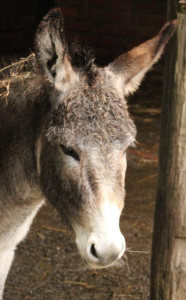By Professor Carol on Dec 16, 2015 04:00 am

KATH (CC BY 2.0)
My daughter Helen long wanted to get a donkey. For whatever reason, it was the animal that most touched her heart (after cats). Donkeys out where we live are working animals, used in pastures to protect small livestock. Donkey’s don’t like coyotes and are extremely good at running them off. They also keep lonely animals company, if a pasture has just one horse or goat, for example.
Donkeys are cheap to obtain (free often) and known for low maintenance. They can eat low-grade hay in the winter. And they usually have a good temperament, although their legendary stubbornness can be coupled with a mean streak too. That’s useful in guarding livestock, but not so pleasant for the owner.
In the Bible, donkeys are mentioned more often than any other animal. They are one of the earliest to appear in the Scriptures and they figure as key players or backdrops in stories of importance, both within Judaism and Christianity. But it’s no wonder, as they’ve been recorded within civilization for longer than 5000 years as primary beasts of burden.
Donkeys symbolize industry, peace, and modest affluence. Industry, of course, because they carry burdens (although not as many as the more powerful oxen). Peace because they rarely figure into an army’s actual battle strategy (it’s hard to fight on a donkey). And wealth? Well, a modest wealth at best, since donkeys have never been a high-dollar animal.
Contrast that with the horse. High-dollar creatures, horses express mighty qualities in paintings, sculpture, poetry and song. Horses are symbols of war, wealth, and power. Yet, if you’ve cared for both equines, you know that horses are harder to keep healthy than the lowly donkey.
Lowly. That’s the word we often hear associated with both cattle and donkeys, particularly when we think of nativity scenes. Think how often you see a diminutive donkey modestly intruding its head to gaze upon the Christ Child. But the donkey, per se, is not mentioned in any of the Gospel narratives of Christ’s birth, although what stable in a town bustling with activity during the tax season would have been without them?
The earliest account of a donkey at Christ’s manger comes from a document in 1415, where, in a live nativity scene, Jesus is described as lying between an ass and an ox.
Ass, of course, is the biblical term for a male donkey. (Today, the she-ass is generally called a Jenny). The English name donkey itself doesn’t appear until around 1785 and may refer to its dull grey-brown color. The word “monkey” may have affected the name, while other etymology relates the name to “Duncan” or to the Spanish name “Don.”
The critical role played by our Biblical donkeys would be symbolic, uniting prophecy from the Old Testament with Christ’s triumphant ride into Jerusalem, in anticipation of his Crucifixion. Donkeys are also one of only two animals able to speak in the Bible (Numbers 22), the serpent being the other.
But none of this persuaded us to get Helen a donkey—at least, not at the time. We had goats, horses, cows, cats, and way too many dogs in those years. Now she’s grown, with two children of her own. And, as you might guess, she says that one day, she wants us to get them a donkey. I hope we can since the symbolism of the donkey has come to speak to me in a much stronger way. We just have to find one with an even temper!
Read in browser »
 
Recent Articles:
|
No comments:
Post a Comment